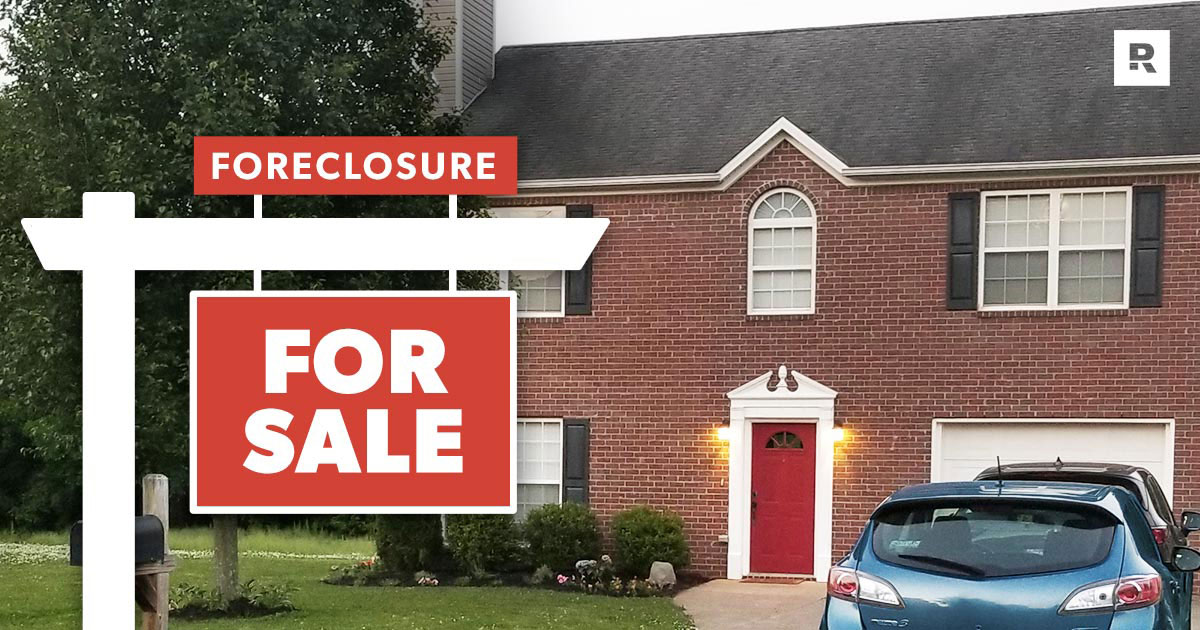If you’re facing a foreclosure, know this: You will get through it. Yes, it can be a long and hard road. But there is hope.
We’re here to walk you through what happens during the foreclosure process, so you know what to expect—and so you can take steps to avoid a foreclosure altogether.
What Is Foreclosure?
How Many Mortgage Payments Can I Miss Before Foreclosure?
How Does Foreclosure Work?
How to Avoid a Foreclosure
Foreclosure FAQ
What Is Foreclosure?
A foreclosure is a legal process that begins when a homeowner has stopped paying (or defaulted on) their mortgage. To recover the balance of the home loan, the lender may force the sale or auction of the property.
That may sound unfair, but if you have a mortgage, your home is technically owned by the bank or mortgage lender—which means they have the right to take it back if you aren’t paying them.
Consequences of a foreclosure include:
- Losing your home or property
- Losing any equity you had in your home or property (that’s the amount of your home you actually own)
- Damaging your credit
- Owing your lender money after your home is sold (this is called a deficiency balance)
How Many Mortgage Payments Can I Miss Before Foreclosure?
Usually, a foreclosure begins once you miss four consecutive mortgage payments (or are 120 days late) on your home, property or timeshare.
While one missed mortgage payment technically breaks your mortgage agreement and can result in late fees, most lenders won’t start the foreclosure process after one missed payment (though they can if they want).
Lenders generally try to avoid foreclosure if possible because it costs them time and money. So, in most cases, they’ll offer some options to help you lower your mortgage payment, especially if you have a legit reason you can’t make your payments (like losing your job).
But if you keep missing payment after payment without talking to your lender, they may start the foreclosure process sooner rather than later.
How Does Foreclosure Work?
It isn’t pretty, but if your home is at risk, you need to know the nitty gritty about what happens in a foreclosure. Keep in mind, the foreclosure process could look a little different depending on the state you live in and the type of foreclosure you’re going through.
There are three types of foreclosures:
- Judicial: This type of foreclosure goes through the court system (and is one of the most common types of foreclosure).
- Power of sale (non-judicial): Your lender can put the home up for auction without the oversight of the judicial system.
- Strict: The property goes back to the lender after a court-ordered time period. In strict cases, the home is usually worth less than what’s owed on it.
Again, everyone’s circumstances and the rules in each state vary, but foreclosures tend to happen in these five stages:
1. You miss a few mortgage payments.
Of course, you never expected to miss a payment when you first held the keys to your new home. But it happens. There are a lot of reasons for a missed mortgage payment: job loss or loss of income, divorce, death of a loved one, medical emergencies, higher interest rates or other bills that keep piling up.
Get help with your money questions. Talk to a Financial Coach today!
Whatever the reason, a few missed mortgage payments can bring on a foreclosure. If you’ve had a life event that impacts your ability to make your payments, the best thing to do is contact your lender and let them know immediately. They might be able to give you grace on your payments for a few months (under what’s called a special forbearance) or work out a different payment plan until you can catch up on your payments.
2. Your lender submits a notice of default.
When you’re behind on your payments for at least four months, your lender will submit what’s called a notice of default to the county recorder’s office. This is a document that says you’ve broken your mortgage contract by not paying your agreed amount when it was due.
But this usually doesn’t happen without your lender contacting you several times and asking for payment. And when they submit the notice of default, they’ll also send you one via certified mail. In other words, this part won’t be a surprise.
The notice of default is the official start of the foreclosure process. But listen, if you’ve just received a notice of default, it’s not too late! Your lender will usually give you three months to get caught up and reestablish the home loan. So, contact them! Let them know how much you can put toward the loan and when, and you might be able to get back on track and avoid the rest of this process altogether.
3. Your home goes to the pre-foreclosure stage.
Once your lender or bank has submitted their notice of default to the county recorder, your property is now in the pre-foreclosure stage. At this point, you have a few options:
- Catch up on your payments (if you can).
- Try to sell your house.
- Sign the home over to your lender with what’s called a deed in lieu of foreclosure.
Sometimes, if you owe more than your home is worth, you have a home equity loan, or the real estate market isn’t great, you may have to sell your home in a short sale.
A short sale is similar to a regular home sale—except you’re trying to sell it as fast as you can at a lower price to beat the foreclosure. The name short sale comes from the fact that the house is listed for a price short of the mortgage balance. Your lender will have to approve the sale, but it might be the best option if you aren’t able to sell the house outright.
Now, if you can’t sell your house (even in a short sale), you can choose to give the deed of your home back to the lender with a deed in lieu of foreclosure. With this option, you’re basically giving up the house (and the mortgage), which lets your bank skip the long—and expensive—process of a foreclosure.
4. Your lender takes the home to auction.
If your lender doesn’t approve a short sale or if no one buys your house in the short sale, then what? Well, at that point, your lender will file a notice of sale and appoint a trustee to take the property to auction. The trustee will start the bid at the amount left on your mortgage balance, and the sale usually goes to the highest bid.
In some states, even if the property goes to auction, you as the homeowner still have the right to try to purchase the home (this is known as the right of redemption). Here’s the deal though: You’d have to pay the balance (and interest), plus anything your bank spent going through this process. And another lender probably isn’t going to risk taking you on at this point. So, as hard as it is, you’re better off letting the house go.
Also, if the home sells for less than what is owed on it, your lender may come after you for the difference (called a deficiency balance). Whether or not you have to pay depends on the state and the type of loan, but just know that you could continue to owe your lender money even after a foreclosure.
5. You get evicted.
If the house doesn’t sell at auction, the property becomes the full responsibility of the bank or mortgage company (taxes and all). At this point, the bank is very motivated to sell the property and get it off their hands (and their bottom line). If you’re still in the home, your lender will want you out as soon as possible—which means eviction.
Now, the word eviction probably brings up a lot of fear. But take a deep breath. Your lender will let you know the exact date you need to be out of the house by. And you’ll have at least a couple of days (usually longer) to move out.
But listen, don’t wait until the last minute to find a new place to live. Yes, it can be a lot to deal with in the moment. But the last thing you want is someone who works for the bank tossing your belongings into the front yard.
How to Avoid a Foreclosure
We know a foreclosure can feel terrifying and hopeless. But whether you’re worried about making your mortgage payment or you’ve already missed a couple of payments, there are things you can do to avoid losing your home to foreclosure.
Talk to your lender.
We’ve said this a couple times, but it’s worth calling out again: Talk to your lender—and don’t stop talking to your lender.
Yes, this whole situation is stressful and scary, and you might even be embarrassed. But ignoring the reality of what’s happening won’t help you (it may actually speed up the foreclosure process).
You may be able to avoid a full foreclosure if you open up a clear line of communication with your lender. That way, they can work with you to adjust your loan terms or set up a more manageable payment plan while you get caught up. So, reach out as soon as possible!
Catch up on payments.
If you’ve fallen behind on your mortgage payments, you may be tempted to just throw in the towel. But there are things you can do to catch back up!
- Get on a budget. You can’t take control of your money if you have no clue where it’s going. A budget gives you a game plan for the month—so you can actually make progress on your mortgage payments.
- Lower your other expenses. If you’re at risk of losing your home, you need to get real about your spending. Focus on covering the basics: getting food on the table, keeping the lights on, and putting gas in the tank. This is not the time to be buying clothes, going out to eat, or shopping on Amazon. This is the time to save as much money as possible—so you can pay your lender what you owe them.
- Increase your income. If you’ve cut your spending and still don’t have enough to give your lender, you need to get busy boosting your income. Sell stuff, work extra hours if you can, or get a side hustle (or two). Start earning money like your house depends on it (because it does).
Connect with a financial coach.
A foreclosure can be brutal. But you don’t have to go through it alone. You need someone in your corner who will listen and talk you through all your options—without any judgement.
If you’re facing a foreclosure, a Ramsey Preferred Coach is here for you! They’ll walk you through your specific situation and help you get back on your feet. Don’t wait—go ahead and connect with a coach today.
Read the full article here


















